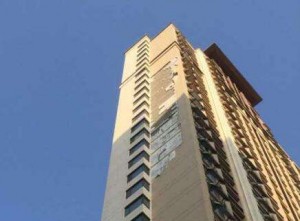Our common external wall insulation problems usually occur some time after the completion of construction, or after alternating winter and summer temperature cycles, which imply different problems in engineering quality, construction technology, raw material supply, and formulation deployment. Industry professionals will explain the reasons and solutions to these problems for us to avoid similar problems.
1. The outer wall insulation layer falls off
The external wall insulation layer falls off because of the uneven quality of the materials used, and the workers’ inattention during the construction process. At this time, the external wall insulation board is prone to displacement, hollowing, and falling off, and the slurry insulation layer has hollowing and Fall off. If it is not handled in time, the insulation effect of the wall will be greatly reduced.
Reasons for peeling off of outer wall insulation:
1. Basic-level structural factors. The outer wall of the frame structure is at the joint between the concrete beam and column and the masonry, which is prone to damage to the insulation layer caused by the deformation of the masonry. The scaffolding openings are not solidified, and the local base layer of the thermal insulation layer is not strong and damaged. The external wall decoration components are not firmly fixed and displaced, forming a push-pull effect, which causes the insulation layer to partially hollow and cause long-term water seepage after cracks, which will eventually cause the insulation layer to fall off;
2. Improper anti-stress measures. The surface load of the insulation board is too large, or the negative wind pressure resistance measures are unreasonable. For example, the non-nail bonding bonding method is adopted for the outer walls of coastal areas or high-rise buildings, which can easily cause the insulation board to be damaged by wind pressure and the hollow drum will fall off;
3. Improper handling of wall interface. Except for clay brick walls, other walls are treated with interface mortar and then coated with slurry insulation materials. Otherwise, the insulation layer will be directly hollowed or the interface treatment material will fail, forming the interface layer and the main wall hollow, and jointly forming the insulation layer void drum. The surface of the insulation board also needs to be treated with interface mortar, otherwise it will cause local hollowing of the insulation layer.
Second, the surface layer is cracked
The exterior wall thermal insulation plastering layer is composed of plastering mortar and reinforced mesh. The plastering mortar is divided into bottom mortar and surface mortar. According to the editor of Wuhan Decoration Network, when applying the surface layer, first apply the bottom layer mortar to the surface of the installed external insulation board, add a reinforcing mesh, and lightly wipe the reinforcing mesh into the bottom layer mortar, and then apply the surface layer mortar on top , The thickness shall not be less than 3 mm, and the pattern must be exposed without the net.
Plastering mortar, also known as anti-cracking mortar or anti-cracking mortar, plays a key role in the entire external thermal insulation system and builds a reliable and reinforced protective layer for external thermal insulation boards. The cracked surface layer cannot solve the problems of heat preservation, heat insulation, wind pressure resistance, fire resistance, freeze-thaw resistance, waterproof, weather resistance, flame retardant, ventilation, and cracking of external insulation.
Reasons for cracking of the surface layer:
1. Material factors. The density of the insulation board for external wall insulation should be 18~22kg/m3. Some construction units will use the insulation board below 18kg/m3. The density is not enough, and it is easy to cause cracks in the plastering mortar layer; the natural shrinkage of the insulation board is In the natural environment for up to 60 days, due to factors such as capital turnover and cost control of the production enterprise, the insulation board that has been aged for less than seven days has been installed on the wall. As a result, the insulation board continues to shrink after being installed on the wall, adhere and then heat insulation The plastering mortar layer on the board is cracked;
2. Construction technology. The flatness of the surface of the base layer is too large, and the use of adhesive thickness, multi-layer boards, and surface polishing to find equal adjustment methods will cause defects in the quality of insulation; dust and particles on the surface of the base layer that hinder adhesion are not treated with interface; insulation board bonding The area is too small, does not meet the specifications, and does not meet the quality requirements of the bonding area; when the rice surface mortar layer is constructed under exposure to the sun or high temperature, the surface layer loses water too quickly and causes cracks;
3. The temperature difference changes. The thermal conductivity of the two layers of expanded polystyrene board and crack-resistant mortar is different. The thermal conductivity of expanded polystyrene board is 0.042W/(m·K), and the thermal conductivity of crack-resistant mortar is 0.93W/(m·K). The thermal conductivity differs by 22 times. In summer, when the sun shines directly on the surface of the plastering mortar, the surface temperature of the plastering mortar can reach 50~70℃. In case of sudden rainfall, the temperature of the mortar surface will drop to about 15℃, and the temperature difference can reach 35~55℃. This kind of temperature difference and the influence of the temperature difference between day and night and the seasonal temperature result in a large amount of deformation of the plastering mortar layer, which is prone to cracks.
Three, indoor condensation
Because there are too many decorative lines picked out by concrete in the inner wall, and the proportion of concrete pouring has been determined during insulation, the insulation treatment of this part is abandoned. These exposed concrete parts without insulation treatment will cause indoor frosting , Condensation can easily lead to damp and moldy walls.
Reasons for indoor condensation:
1. The node design of the window is unreasonable. In energy-saving design, there is only one principle for the design position of the window, which is to set different positions according to the different forms of heat preservation. When using external insulation, it should be close to the outside of the wall. Try to connect the insulation layer and the window as a whole to reduce the insulation break between the insulation layer and the window and avoid thermal bridges. Some designers neglect the influence of heat transfer on the heat consumption index of the outer window in the design, and do not adopt the thermal insulation design treatment for the windows around the opening of the outer window. This leads to indoor condensation;
2. The cold and hot bridge is formed. The design of the insulation breakpoint is unreasonable, leading to the formation of a thermal bridge effect around the window hole. The indoor humidity dead angle should be improved, and good ventilation conditions should be maintained to fundamentally block the thermal bridge;
3. The waterproof design is unreasonable. In the design of the window, the drip treatment of the upper mouth of the root and the waterproof design treatment of the root of the lower mouth of the window are not considered in the design of the window. Water easily enters the interior of the insulation system from the connection part of the insulation layer and the window root, thus causing harm to the external insulation system.
Fourth, the external wall tiles are hollow and fall off
It is not uncommon for people to be injured by falling bricks and materials on the exterior wall. Quality problems caused by mistakes in construction, the influence of temperature, etc. may be one of the factors that cause problems with exterior wall tiles. In addition to making the appearance of the wall unsightly, accidents are also prone to hollow and falling tiles.
Reasons for hollowing and falling off of external wall tiles:
1. Temperature changes. The temperature difference between different seasons and day and night causes the veneer brick to be affected by three-dimensional temperature stress. The veneer layer will produce local stress concentrated on the vertical and horizontal walls or the junction of the roof and the wall. If it is in the middle of a large area of the wall, or Local extrusion of adjacent tiles will cause the tiles to fall off;
2. Material quality. Because the plastering mortar layer is deformed and hollowed out, causing the facing bricks to fall off in a large area; the composite wall composed of the incompatible materials of each layer and the deformation are not coordinated, resulting in displacement of the facing bricks; the waterproof measures of the external wall are not in place. Lead to moisture infiltration, causing repeated freeze-thaw cycles, causing damage to the bonding layer of the tile and causing the tile to fall off;
3. External factors. Some external forces can also cause the facing tiles to fall off. For example, uneven settlement of the foundation causes structural wall deformation and dislocation, causing serious wall cracks and falling off of the facing tiles; natural factors such as wind pressure and earthquakes can also cause the facing tiles to fall off.
Post time: Jan-11-2021





